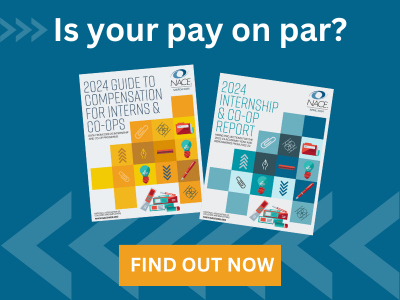Ryan Elder, senior director of HR and talent development at Mohawk Industries, remembers the uncertainty he experienced during his transition from college to the workforce.
“I had no idea what I wanted to do with my career,” Elder recalls.
“I changed my major several times throughout my college career and was still trying to figure out what I wanted to be when I grew up. We sometimes lose sight of the exploration that those transitioning to the workforce will go through to truly determine what they are passionate about and what they want to spend their careers working toward.”
NACE23 Preconference Workshop: From College to Corporate—Bridging the Gap With Early Career Programs
Join Mohawk Industries’ Ryan Elder, senior director of HR and talent development, and Jessica Nguyen, Ed.D., university relations manager, for the “From College to Corporate—Bridging the Gap With Early Career Programs” NACE23 preconference session. This four-hour session will help you identify challenges and develop solutions for connecting college to corporate for students through early career programs and university partnerships.LEARN MORE
Mohawk Industries realizes that there is tremendous value in connecting college to career for students.
For example, Elder acknowledges the potential difficulty with important life transitions.
“These include the often-abrupt end of college and transition to a career stage of life that involves relocation, establishing new support networks, and the development of routines,” Elder says.
“This can be overwhelming for anyone. We believe it is our responsibility to do what we can to support the transition, which is just one of the many reasons our ASPIRE program is so important. We emphasize the cohort, are intentional in establishing a support network, and ensure they have mentors to connect with.”
Mohawk Industries’ ASPIRE Rotational Development Program is a 12- to 24-month program that takes graduates through five rotations and provides a large scope of visibility into their business area, technical and soft skill training, and increased exposure to executive leadership.
Jessica Nguyen, Ed.D., Mohawk Industries’ university relations manager, says there is much more to graduating students’ transition than going from classroom to workforce. There’s an adjustment period to:
- Supervisors;
- Office politics, for some;
- A full workday
- New skills; and
- Applying what they’ve learned in the classroom to an actual work project or task; and more.
“It’s figuring out the interpersonal relationships and navigating your place in the pecking order sometimes,” Dr. Nguyen says.
“The cohort approach to ASPIRE and the added mentors can definitely assist with these transitions to help ensure their success. We also do different assessments with them to help discover their leadership or communication style, for example, which can help them understand relationship building as they identify and become aware of how they are perceived and how they perceive others and how best to communicate with others.”
When connecting college to career, there are some potential missteps for career services offices and URR departments to avoid.
“I don’t believe any of the missteps are intentional as everyone is trying to do what is right for their organization and their students,” Elder says.
“It’s important to remember that while these are two distinct stages in life, it doesn’t mean we must treat them as such. Can you develop mentorships or other programs that help students coming to the end of their college career to transition more effectively? As an organization, what are you doing to help keep individuals connected to their institutions? We actively work with our university partners and our employees to ensure those connections are in place. Ultimately, I believe we must treat the change as a sliding continuum that may, at times, require someone to move backward before they can move forward.”
Dr. Nguyen explains that issues may arise because small teams are trying to adequately serve large numbers of students.
“Many career services offices have a small number of staff members who are serving very large student populations, as well as some URR teams being small in number while being responsible for a large number of college partnerships, events, and new employee hiring,” she points out.
“There is also the factor of students needing to be involved in their own journeys. We can offer programming, networking opportunities, training sessions, and other ways to connect all day, but if students don’t make the effort to show up and get involved, there’s only so much we can do for them.”
The Mohawk Industries URR team has found it incredibly beneficial to use design thinking principles to bridge the connection between college students, career services, and employers.
Says Elder: “Empathizing with all of the different groups that we interact with through stakeholder mapping provided valuable insight into how important it is for us to ensure a quality experience for early career talent.”
During the ideation stage, the team pulled in several different stakeholders to help overcome the obstacles it faced. Doing so also enabled the team to create buy-in within each of the stakeholder groups as they were involved with developing solutions.
“Lastly,” Elder continues, “we are in a constant state of testing and refining. If we see a problem, we re-engage our stakeholders to ideate and continuously revisit the process.”
Dr. Nguyen says that design thinking works for all of the groups involved, which is why it’s so invaluable in the process of helping students transition from college to career.
“Every school and employer is different, so utilizing design thinking allows everyone to individualize their plan and support students the best way they can in the way that their students need,” she says.
Mohawk Industries uses its own competency framework, but also uses the NACE career readiness competencies to understand what its career services partners are focused on and identify where there are intersections and gaps.
“Having come from career services and now working on the corporate side, I believe the NACE competencies give both groups a way of connecting across their different spaces,” Dr. Nguyen explains.
“The competencies allow employers to identify areas they need students to have skills in—and tell where students are lacking when they enter the workforce—so career services members can help students to develop these skills before they hit the workforce, ensuring a more successful transition for them.”
Elder and Dr. Nguyen offer suggestions for bridging the gap from college to corporate with early career programs:
- Be curious. Ask questions, listen to the answers, ask more questions and genuinely be interested in the answers. Listening is so important in bridging the gap, but it’s not just listening to what is said, its hearing what isn’t said. What are your stakeholders not considering or thinking about? Are there things they are taking for granted or expectations they hold?
- Continuous improvement is needed by all of the groups involved. Students need to be curious, ask questions, and listen, too, but then be innovative in bringing new ideas to the table when questioning why a process is the way it is, or if it can be improved? Career services and URR staff have to continuously be creative and investigative as well. How do we get students involved? What matters most to them so we can provide those answers/experiences? What changes are happening in the workforce that we need to be aware of to educate students about before they transition? It’s a never-ending cycle of curiosity and continuous learning.
Dr. Nguyen stresses the importance for both URR and career services to be aware of the learning process for students and to continuously take that into consideration.
“We look at internships from a business standpoint of creating a talent pipeline; however, from a career services view, internships are a way for students to explore career options and figure out what they do or don’t want to do,” she notes.
“It’s important for both sides to support that for students who may think this is just a job or they have to do a certain job because it’s what they have always wanted to do or is what their degree is for, but they’re miserable and don’t like the work when they get to it. We need to let them know internships and early career opportunities are for exploration and we support them learning that something isn’t the right fit for them just as much as we support them finding their dream job.”
Mohawk Industries’ ASPIRE program helps with this exploration by offering rotations through different areas so students can explore and discover their “best fit.”
“Not everyone gets that opportunity, so it may be job hopping when they first get out of college or interning at different companies or in different groups each summer,” Dr. Nguyen adds.
“This may seem like a bad thing to employers and career services, but although we know job hopping after just a few months is not good, it should be encouraged to a lesser extent if we’re focusing on what’s best for the students’ growth.”






